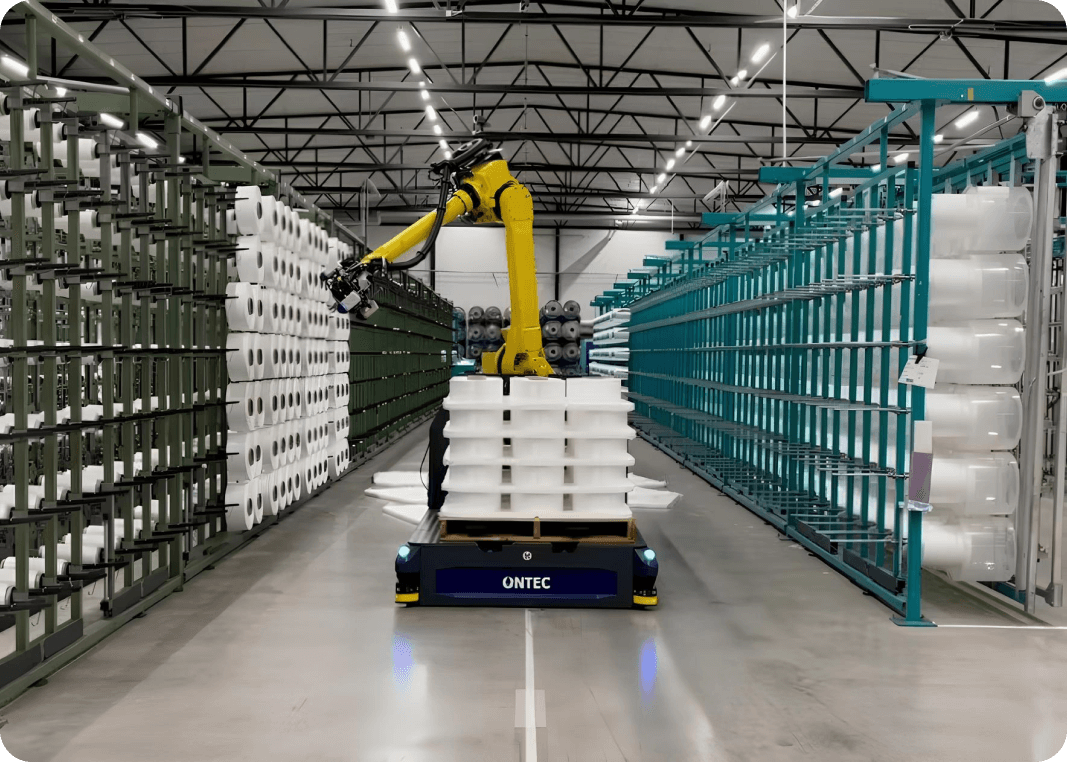Cookie 设置
点击 "接受所有 Cookie",即表示您同意在您的设备上存储 Cookie,以增强网站导航、分析网站使用情况并协助我们的营销工作。更多信息
详细了解纺织业的人工智能如何推动创新、实现更智能的生产流程,并为该行业的未来做好准备。

纺织业是世界上最大、最重要的行业之一,涉及面料和服装的生产、设计和销售。2023 年,全球纺织业的产值为 1.84 万亿美元,由于对高质量和定制产品的需求不断增长,预计到 2033 年将达到 3.77 万亿美元。为了满足这一不断增长的需求,人工智能(AI)可以在整个行业中提高生产率、推动增长和激发创新。

人工智能可以帮助纺织品生产,处理预测性维护和织物检测等任务,同时提高质量并减少浪费。在本文中,我们将探讨人工智能如何在纺织品生产中提高质量、增加效率和支持可持续实践。我们还将讨论未来在纺织生产中采用人工智能技术的潜力和挑战。让我们开始吧!
传统的纺织品生产包括多个手工和机器步骤,如纤维纺纱、编织或针织、染色和后整理。这些方法在很大程度上依赖熟练劳动力,往往会造成错误和织物浪费。现在,人工智能有助于使生产更快、更准确、更少浪费。通过让机器变得更智能,人工智能减少了对持续人力投入的需求,有助于简化整个流程。
以下是人工智能对纺织品生产各个阶段的影响:

既然我们已经讨论了人工智能如何让纺织品生产更快、更智能、更高效,那么就让我们来详细了解一下改变当今纺织品生产的一些关键创新。
在纺织品生产中,质量控制用于检查织物,确保其符合特定标准,如一致的颜色和图案。检查织物是否存在缺陷,如图案错位、线头松动和颜色变化。计算机视觉可用于扫描织物是否存在这些缺陷。安装在布料上方的高分辨率摄像头可以高速扫描布料的整个宽度,利用明亮的光线捕捉详细的图像,以突出褶皱、污渍或松散线头等细微缺陷。
对象检测和实例分割等计算机视觉任务可以实时分析这些图像。对象检测可以识别和定位特定的缺陷,而实例分割 则可以更进一步,以像素级的精度分离出单个元素,如线程或图案。这些方法有助于精确定位缺陷,并区分正常变化和实际缺陷。通过及早发现问题并减少浪费,最终可以加快检测速度,提高准确性、一致性和效率。
例如,WiseEye 系统就是视觉人工智能用于织布机织物缺陷检测的绝佳案例。它利用计算机视觉识别 40 多种疵点,包括褶皱、污渍和颜色不匹配,准确率超过 90%。该系统能以高达每分钟 60 米的速度检测织物,适用于平纹、斜纹和针织等多种材料,以及纯色、条纹和格子等图案。

您知道单一颜色的色调比您想象的要多得多吗?色调、亮度和饱和度的细微差别会造成很大的不同,尤其是在纺织品生产中。配色是实现各批纺织品色调统一的过程。以前,配色需要人工检查和手动调整,容易出错。在解决织物配色问题方面,人工智能已经改变了游戏规则。机器学习和计算机视觉可以提供更加准确、一致和高效的解决方案。

基于人工智能的色彩匹配系统使用高分辨率摄像头,在受控照明条件下捕捉织物样本的详细图像。计算机视觉对这些图像进行分析,以评估色调、亮度和饱和度等关键色彩属性。系统将这些属性与目标色调进行比较,同时考虑织物类型和照明等变量。人工神经网络(ANN)根据大量数据集进行训练,预测染料在不同条件下的表现,从而使人工智能能够高精度地提出最佳染料配方建议。
人工智能将曾经是劳动密集型且容易出错的任务自动化,可确保更快、更可靠的结果,从而改变纺织品在不同生产批次中实现一致质量的方式。
创造几乎没有废弃物的时装面临着不同的挑战,但人工智能正在帮助时尚界将这一愿景变为现实。数字孪生技术和预测建模等先进工具正在帮助解决减少浪费和改善服装合身性等长期存在的局限性。
数字孪生是一种虚拟模型,它能准确地代表现实世界中的物体,如人的身体。通过使用生成式人工智能,身高、体重、年龄、体形甚至姿势 等基本输入信息都可以用来创建一个详细的个人测量数字表示。它能捕捉肩宽、腿长和躯干比例等精确细节。这些先进的功能可以让服装品牌提供高度个性化的尺码建议,确保更合身,减少退货,提升整体购物体验。
SXD 首席执行官Shelly Xu 利用这些技术来解决大量织物废弃的问题。每秒钟就有一辆垃圾车的织物被填埋或焚烧。Xu 与人工智能专家合作开发了 SXD AI,这是一个能快速、高效地调整零浪费设计的平台。
该平台的一个主要特点是使用人工智能驱动的 "自适应图案"。这些是由生成式人工智能驱动的动态数字设计,可以根据不同的尺寸、体形和面料类型自动调整,无需人工重新设计。过去需要数周的手工劳动,现在可以即时完成,从而实现了灵活性和精确性。这项创新可减少高达 46% 的面料浪费,降低成本,加快生产速度。

我们已经介绍了人工智能应用于纺织品生产的各种方式,现在让我们来讨论一下人工智能能为这个行业带来的一些关键优势:
虽然这些优势表明人工智能可以改变纺织业,但考虑到其实施过程中的挑战也很重要:
人工智能可能很快就会彻底改变我们思考和使用织物的方式。电子织物(或称电子纺织品)集成了传感器、导电纱线和微处理器等数字元件,能够感知周围环境并做出反应。这些智能织物能适应温度、运动或压力的变化,将时尚、功能和技术完美地融合在一起。通过与穿着者和环境互动,这些创新纺织品正在重新定义服装的功能。
通过实现个性化互动、健康跟踪和实时数据反馈,人工智能在增强这些织物的整体性能方面可以发挥关键作用。利用深度学习、计算机视觉和先进传感器等技术,人工智能算法可以分析从织物部件收集到的数据。
通过分析得出的见解可以触发特定的行动,例如调整温度或改变颜色。在米兰时装周上展示的香港 AiDLab 公司开发的变色织物就是一个令人兴奋的例子。这种创新材料利用摄像头和聚合光纤(POF)根据手势变换颜色。穿着者甚至可以通过手机上的照片选择颜色,展示了电子纺织品重新定义时尚和康复的潜力。
人工智能正在给纺织业带来根本性的变革,使生产更快、更准确,并支持环保型加工。人工智能工具可以发现微小瑕疵,预测机器何时需要维护,并实时匹配颜色,从而提高质量控制和效率。人工智能还有助于创造出能满足不同需求、符合个人口味的定制织物。随着人工智能的不断进步,它必将推动纺织业实现更大的创新、可持续性和个性化。
了解最新的人工智能技术!查看我们的GitHub 存储库,了解我们的最新进展。与我们的社区联系,了解人工智能如何改变农业和医疗保健等行业。